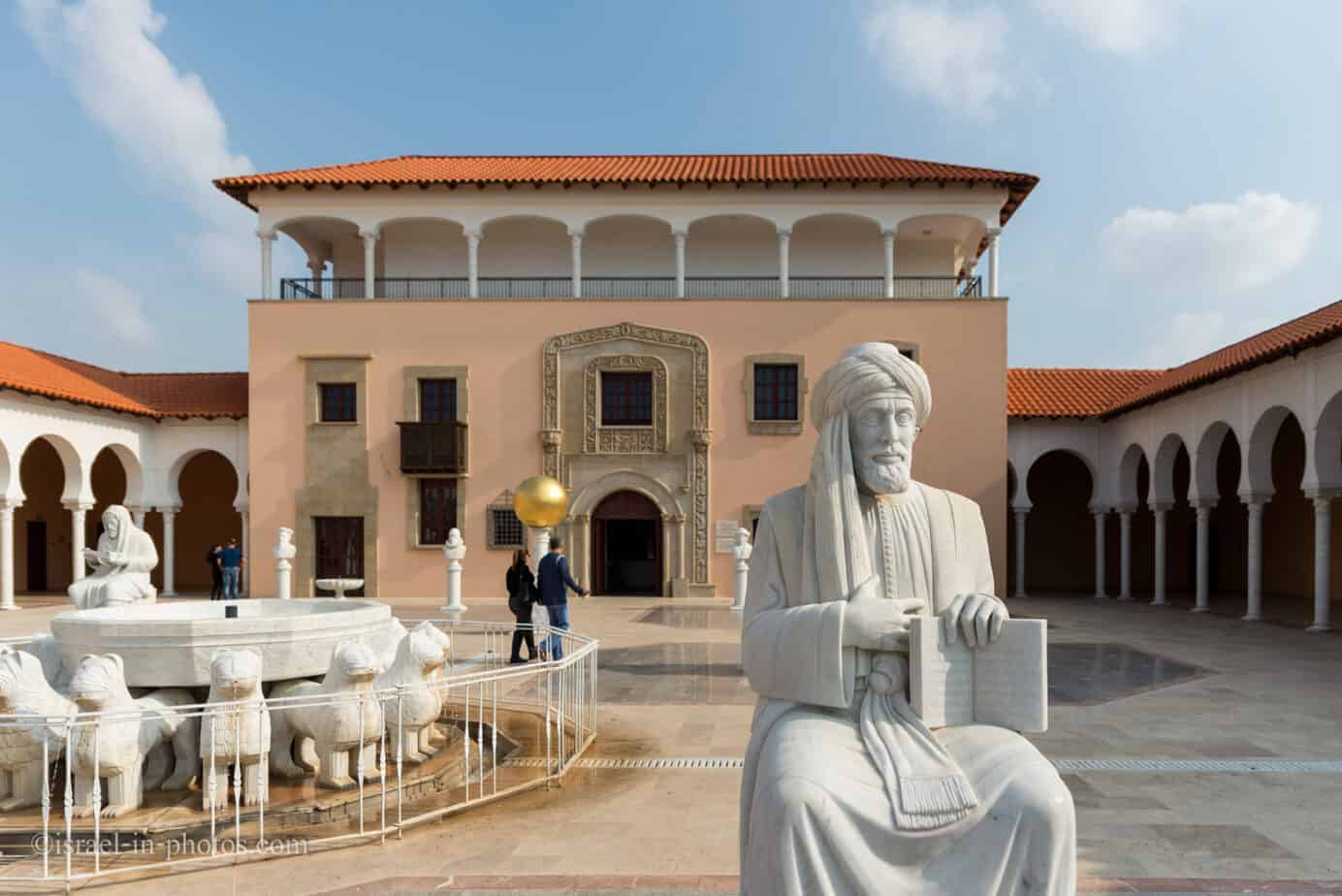Metzudat-Yam Ashdod Ecological Park – Visitors Guide
Metzudat-Yam Ashdod Ecological Park on the shore of the Mediterranean Sea offers three loop trails to explore the surroundings.
Table of Contents
Map
Metzudat-Yam Ashdod Ecological Park is located near Ashdod Yam Fortress. And both are situated by the intersection of Sderot Moshe Dayan and Sderot Yitshak Rabin in Ashdod. The easiest way to reach this spot is by entering “Ashdod Yam Fortress” into Waze.
Directions for drivers: Link to Waze and Link to Google Maps
Directions for public transport: Link to Moovit
Interactive map of the area:
And here is a map of the area:
Note: you can click on the map to enlarge it.
On the map above, you can see Ashdod Yam Fortress in the top left corner. And it is located by the entrance to the ecological park. And I recommend visiting both places together.
Trails
You can use three loop trails to explore Metzudat-Yam Ashdod Ecological Park. And you can see the paths on the map above.
| Trail Name | Color | Length (km) | Description |
|---|---|---|---|
| The Gazelle Trail | Orange | 1.25 | The loop trail that goes through the botanical garden and the beach. You can start this trail at the southern entrance near Be’er Sheva Beach. |
| The Orchard Trail | Green | 0.7 | Leads through the botanical garden and back to the main entrance. |
| Coastal Pathway | Dark Green | 2 | The loop trail that goes through the botanical garden and the beach. You can start this trail at the southern entrance near Be’er Sheva beach. |
As you enter the park, you will see a sign pointing to the trails.

The trails are marked with wooden pillars, and you will be hiking mostly on sand. Thus, wear suitable shoes, and remember that the hike will probably be longer than expected.

Parking
There is a parking lot by the fort (main entrance). It is paid parking lot, and you can pay using your favorite parking app. Parking is free if you are an Ashdod resident registered in their database.

Entrance Fee
Free.
Opening Hours
Always open. But there is no artificial light, and you are requested not to visit at night to avoid disturbing the animals.
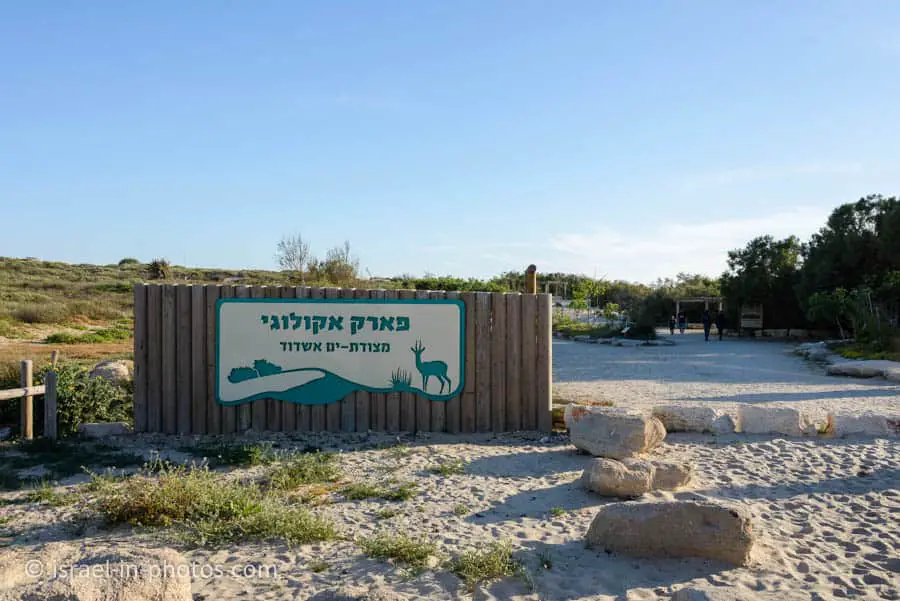
Restrooms
There are restrooms near the entrance to Ashdod Yam Fortress. But the toilets were closed during our visit.
Code of Conduct
It is worth mentioning that:
- Campfires and barbeques are not permitted.
- Walk only on the marked trail.
- Overnight stays are not allowed in the park.
- Dogs must be kept on a leash.
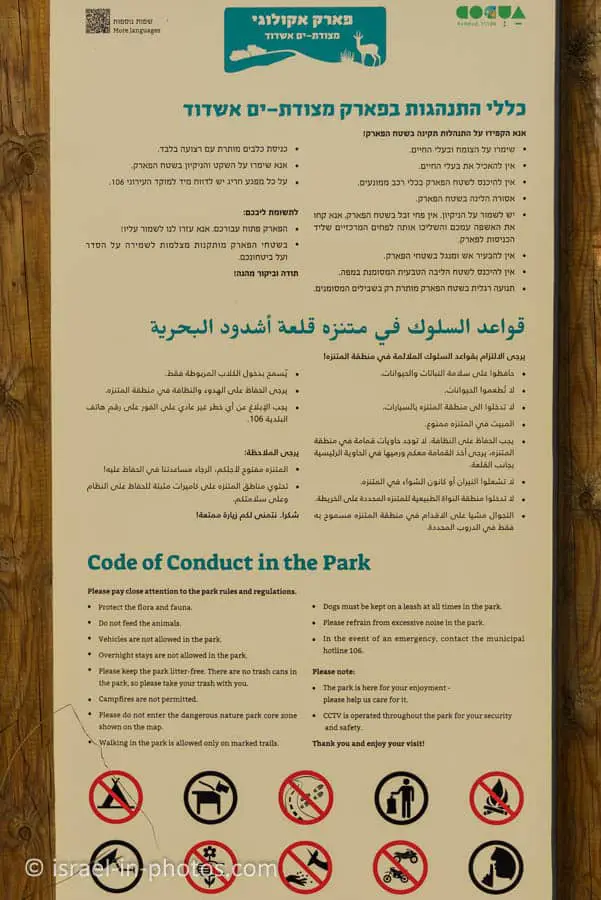
About
The park was established at the initiative of the Ashdod Municipality, in cooperation with the Ashdod Development and Tourism Company, and with support from the Open Spaces Protection Fund of the Israel Land Authority. The city’s residents and local schools neighboring the park helped with planting greenery, trees, and flowering bulbs.
The park will act as an educational focus, teaching pupils from the region’s schools, and as a leisure and recreational facility for the benefit of the wider public. Accessible pathways have been built alongside shaded rest areas and explanatory signs.
The urban nature park was established here for the purpose of preserving and supporting the biodiversity of the park, including a wide range of vegetation native to the local sandy habitat. The nature park boasts remnants of the local moassi agriculture, suited to both shifting and stable sands, and the fertile hamra, loamy soil clearings, as well as a small number of wetlands in the area.
The site has been reclaimed with an abundant variety of species typical of sandy areas, in addition to native shade trees and fruit tree cultivars. The thoughtfully placed plantings, viewing platforms, and shaded teaching spaces are available for the public to enjoy. Great effort was invested in reclaiming and preserving the biodiversity of the park. Please help us to protect the park by following the guidelines.
Source: sign
The Gazelle Trail
During our latest visit, we took the Gazelle trail. And here are several photos from this hike.




We continued towards the gazelle lookout and skipped the Byzantine-era graves. And that is because we joined an Ashdod archeological tour in 2019 and already visited the graves and participated in excavations at Ashdod Yam. And I will show the photos later in this post.


The deer in the park are primarily from the Nitzanim Nature Reserve area along the coastal ecological corridor.
Along the park’s pathways are several odorous Gazelle “scent stations” consisting of deposits of deer droppings left by the alpha males to mark their territory.
The Gazelle is an endangered species and are vulnerable to attack and injury by dogs.
Source: sign
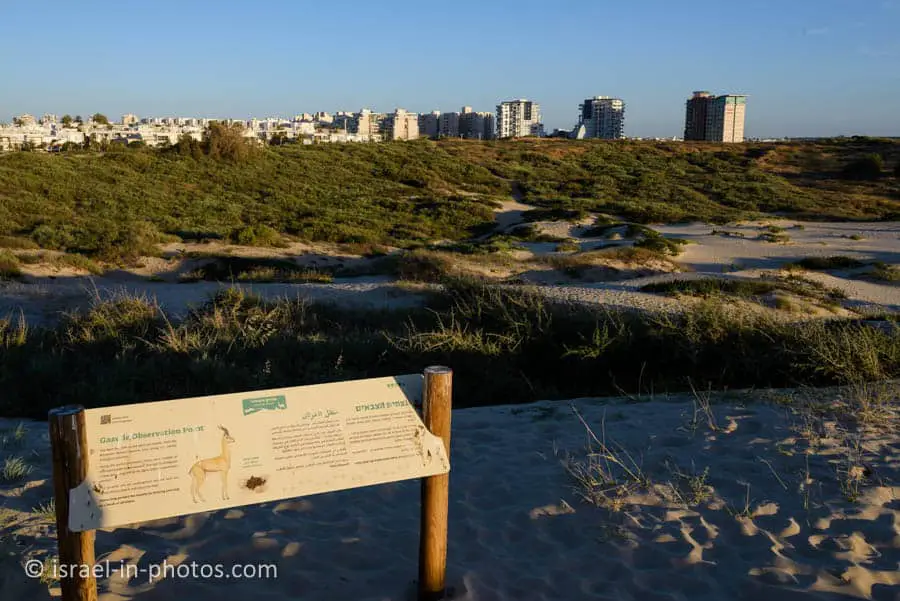
Unfortunately, we did not see any gazelles that day.

From the lookout, we headed to the main entrance. And on the way, we passed through the botanical garden.

Botanical Garden
The climatic conditions of the habitat in the coastal areas, such as high salinity; strong winds; intense sunlight; drifting sands that cover leaves and expose roots; and a lack of a reliable source of water, are challenges to a variety of plant species.
The flora has evolved to survive under these conditions. For instance, sea fennel (Crithmum maritimum) has succulent, thick, water-storing leaves, and the cotton weed plant (Otanthus maritimus) sports silver leaves to help it cope with strong sunlight. The White Broom plant (Retama raetam) has deep, anchoring roots which prevent it from being uprooted by shifting sand and a root system that reaches deep below the surface for year-round moisture.
An additional challenge to the local flora is the non-indigenous, invasive species that create biological contamination, such as camphorweed. This dominant exotic species competed successfully against the native species of the coastal dunes.
Source: sign
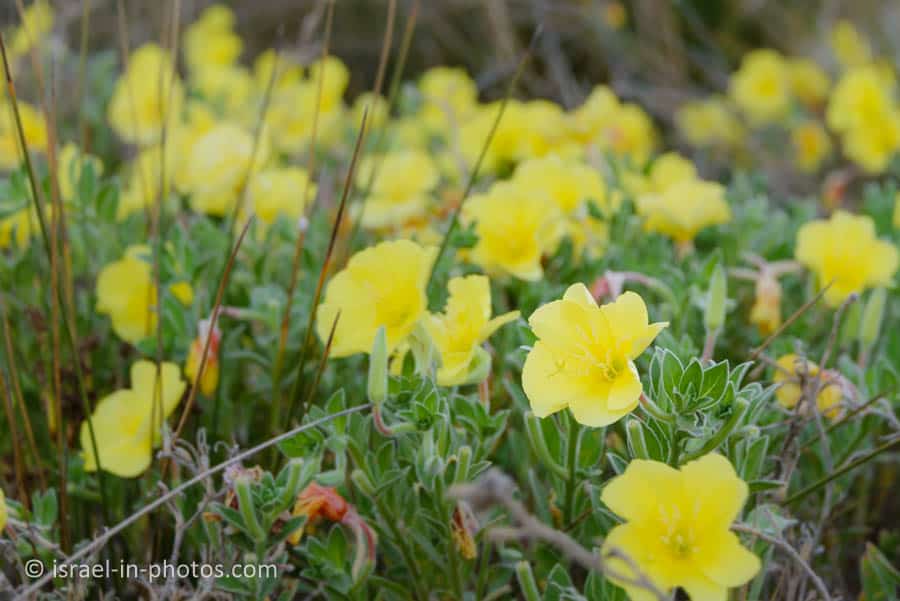

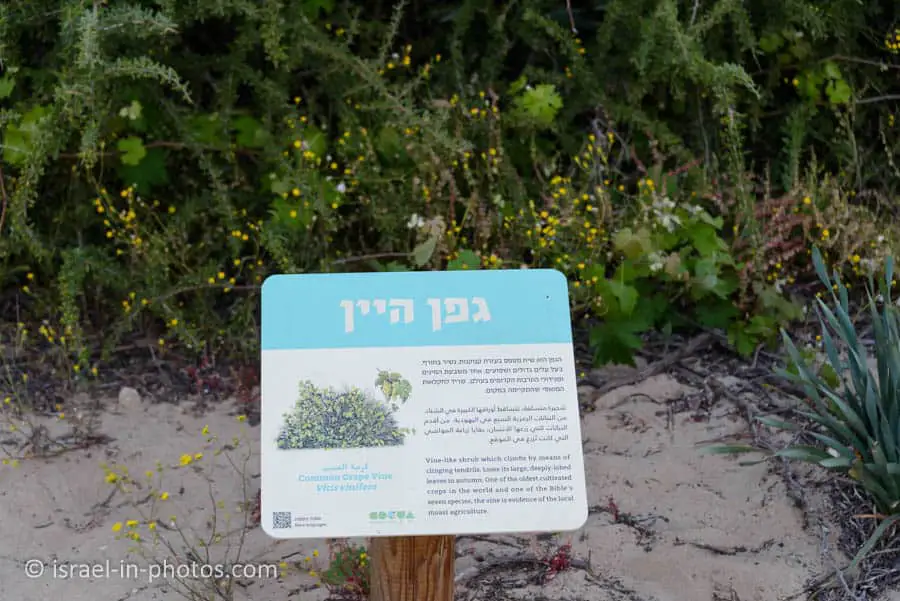
As you can see, there are explanatory signs next to the plants.



It took us an hour at a moderate pace to complete the gazelle trail.
Ashdod Yam
As I mentioned above, we joined an Ashdod archeological tour in 2019. During that tour, we visited Ashdod Yam, which is located near the southern entrance.

The remains here are from a much earlier period (as far as I remember, they are from the Bronze Age).

Also, you can visit this place only as a part of an archeological tour. During our tour, we participated in excavations, visited Byzantine-era Graves, and saw a stunning newly excavated mosaic. We enjoyed the tour a lot.

Interesting fact: Azotos Paralos (Ashdod-Coast) appears on the Madaba map.
Byzantine-era Graves
Excavations carried out by the Israel Antiquities Authority on behalf of ‘Hofit’, the Ashdod Tourism Development Corporation, revealed two burial sites of the Roman and Byzantine periods. The western site includes three vaulted tombs. A Byzantine period mosaic map of ancient Israel in a church in Madaba, Jordan, shows the city of Azotus (Ashdod Yam) with buildings along the Mediterranean coast. The Byzantine period buildings of Ashdod are covered with sand or lie under the fortress of Ashdod Yam. The tombs belong to the cemetery of the ancient city.
Source: sign
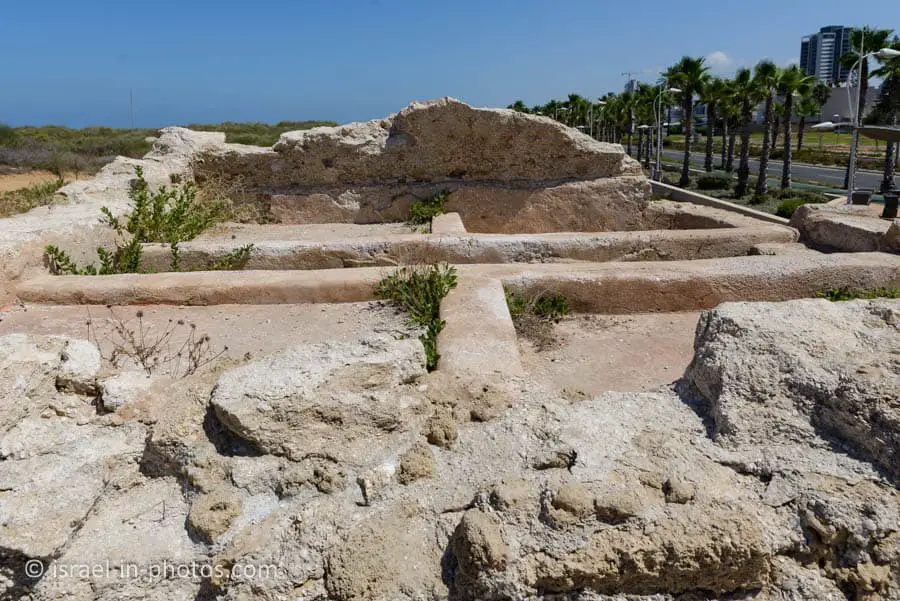


Summary
Metzudat-Yam Ashdod Ecological Park is a lovely place. We enjoyed the hike, and I recommend combining the hike with a visit to Ashdod Yam Fortress.
This area has many attractions. You can explore them using the interactive map above.
Have you visited Metzudat-Yam Ashdod Ecological Park? Tell us in the comment below about your experience.
That’s all for today, and I’ll see you in future travels!
Stay Tuned!
Additional Resources
Here are several resources that I created to help travelers:- Trip Planner with Attractions and Itineraries is the page that will help you create your perfect travel route.
- What is the Best Time to visit Israel? To answer this question, we will consider the weather, prices, holidays, festivals, and more.
- Information and Tips for Tourists to Israel will answer the most common questions tourists have about Israel (including safety, passports, weather, currency, tipping, electricity, and much more).
- Israel National Parks and Nature Reserves include a complete list, top ten, map, tickets (Israel Pass, Matmon, combo), and campsites.
- If you are looking for things to do, here are the pages for Jerusalem, Tel Aviv, Haifa, Sea Of Galilee, Akko (Acre), Eilat, Nazareth, Safed (Tzfat), and Makhtesh Ramon.





